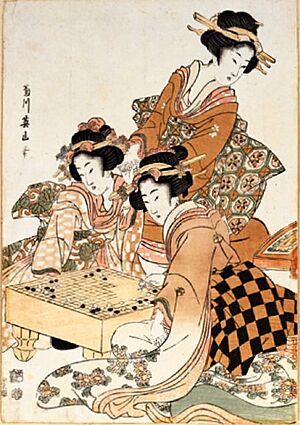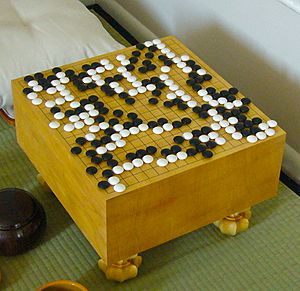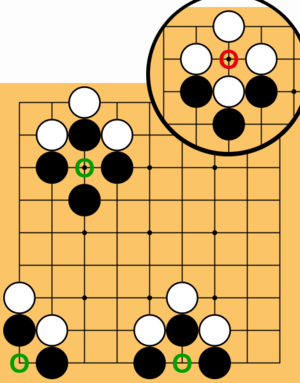Go facts for kids

Go is a fun board game for two players. It has different names around the world. In China, it's called Wei-k'i or Wei-chi. In Korea, it's Patok or Baduk. And in Japan, it's known as I-go.
You play Go on a special board using black and white game pieces. These pieces are called stones. Players take turns placing their stones on the lines of the board. The board usually has a 19x19 grid of lines. The player with the black stones always goes first.
Sometimes, people use smaller boards like 9x9 or 13x13 grids. These smaller boards make the game quicker and a bit simpler. It's a great way to learn the game.
A game of Go ends when both players decide to pass their turn. This usually happens when no more moves will change the score. The winner is the player who has surrounded more empty spaces on the board with their stones. You also add any captured stones and "komi" to the score. Komi are extra points given to the white player to make the game fair. A game can also end if one player gives up.
If you play against someone who is much better than you, they might give you a "handicap." This means you get to place a few extra stones on the board at the start. You also get to play as black, which means you go first. These handicaps help make the game fair for everyone.
Contents
How to Play Go
Go has only a few main rules, besides taking turns and scoring.
- Rule 1: The Rule of Liberty. Every stone on the board needs at least one open spot next to it. These open spots are called "liberties." If a stone or a group of stones loses all its liberties, it gets captured. Captured stones are removed from the board.
- Rule 2: The Ko Rule. The board must never look exactly the same as it did on the turn before. If your move would make the board repeat a past position, you cannot make that move. You must play somewhere else on the board instead. This rule stops the game from going on forever in a loop.
Stones can only be removed from the board if your opponent completely surrounds them. A group of stones stays "alive" as long as at least one stone in the group has an empty space next to it. Stones that have no liberties are captured and taken off the board. At the end of the game, these captured stones count towards the score.
The second rule, the Ko rule, is important. It stops players from endlessly capturing and recapturing the same stone. If a "ko fight" happens, players must make a move somewhere else before they can try to recapture the stone in the same spot.
Go's original name is "围棋" (wei qi or wei chi) in Chinese. It became very popular in Japan, and that's where its common name "Go" comes from. In Korea, it's called "baduk." In these three countries, Go is a big part of their culture. It's like how chess is important in many Western countries.
Go and chess are both board games that need a lot of strategy. They are "perfect information" games, meaning there's no luck or hidden information. This is different from games like backgammon (which uses dice) or poker (which has secret cards).
You can play Go in many places! There are lots of websites to play online. Many cities have local Go clubs, and there are national organizations too. In 2016, a survey found that over 20 million people play Go worldwide. Most of these players live in East Asia.
History of Go
Go was invented in China, but no one knows exactly when. Some people believe it was created over 2,500 years ago. This would make it the oldest board game still played today! The historian H.J.R. Murray, who studied board games, said:
People often say it's older than it is. We only start seeing many mentions of it during the Song dynasty in China (around AD 960–1279). It's interesting that Chao Wu King, who lived between 970 and 1127, wrote about making the Chinese chessboard bigger. He divided it to create the 19x19 board we use now. The game then traveled to Korea and Japan. The first famous Go masters in Japan lived between 1465–1500.
—H.J.R. Murray
Famous Go Players
Some players become very famous for their amazing skills in Go.
Players in Japan
- Go Seigen
- Eio Sakata - He won the honorary NHK Cup.
- Kaku Takagawa
- Hideyuki Fujisawa
- Masao Sugiuchi - He was the oldest professional player from 2004 to 2017.
- Masao Kato - He used to be the president of the International Go Federation.
- Utaro Hashimoto - He started Kansai Ki-in, a big Go organization in Osaka.
Female Players
- Asami Ueno
- Ayumi Suzuki
- Chiaki Mukai
- Chizu Kobayashi
- Izumi Kobayashi
- Kaori Chinen
- Kazuko Konishi
- Keiko Kato
- Kumiko Yashiro
- Mika Yoshida
- Miori Shimosaka
- Narumi Ohsawa
- Reiko Kobayashi
- Rina Fujisawa
- Sachiko Hara
- Sachiko Honda
- Terumi Koyama
- Tomoko Kato
- Tomoko Ogawa
- Xie Yimin - She was born in Taiwan.
- Yukari Yoshihara
Players from Other Regions
Artificial Intelligence Players
Computers have also become very good at Go!
- AlphaGo - This AI was created by DeepMind Technologies, a company connected to Google.
- Darkforest - This AI was made by Facebook. Its computer code is available online.
See also
 In Spanish: Go (desambiguación) para niños
In Spanish: Go (desambiguación) para niños




